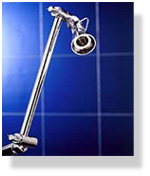By the Numbers...
Do “Low-flow” Shower Heads Really Save Money?

A conventional shower head uses between 3 and 4 gallons per minute (3.5 gpm), while a low-flow shower head uses about 2 gallons per minute (2 gpm).
To find out how many gallons per minute your shower head uses, take a plastic gallon ice cream pail or similar plastic one gallon container and time how many seconds it takes to fill that container.
Now divide 60 by the number of seconds it took to fill your container: 30 seconds = 2 gpm, 20 seconds = 3 gpm, 15 seconds = 4 gpm.
If the average person spends approximately 10 minutes in the shower each day, the difference in water use becomes obvious:
- 365 days per year x 10 minutes per day x 3.5 gpm (conventional shower head) = 12,775 gallons per year
- 365 days per year x 10 minutes per day x 2 gpm (low-flow shower head) = 7,300 gallons per year
The low-flow shower head will save approximately 43 percent of the hot water bill attributed to shower use.
But how much is that?

No matter how you adjust the knobs of the faucet, the end temperature of the water coming out of the shower head will require 1 British thermal unit per degree F per pound of water.
The definition of a British thermal unit is the amount of heat required to raise one pound of water one degree Fahrenheit. This translates to 8.3 Btus per degree F per gallon of water.
The next question to resolve is what water temperature do people use when showering? To solve this question, adjust the water running from a faucet to a comfortable temperature. Run the water over your hand and measure that temperature with a thermometer. Typically, unmixed hot water from the tap measures 110°F, which is quite warm (Water at 120°F will produce a burn in 10 minutes). Mixing cold water lowers the temperature. Water at 102 degrees seems just mildly warm. Most people probably shower with water at about 105 degrees F. For this calculation, 100 degrees F is used which is fairly conservative.

Secondly, how much must each gallon of water be raised to reach that temperature? The temperature of most water that comes into homes is about 55°F. Calculating this part of the savings:
- Water temperature of 100 minus 55= 45 degrees
- With the conventional shower head: 8.3 Btus per gallon per degree F x 45 degrees temperature difference x 12,775 gallons per year = 4,771,463 Btus per year
- With the low-flow head, 8.3 Btus per gallon per degree F x 45 degrees temperature difference x 7,300 gallons per year = 2,726,550 Btus per year
- Converting British thermal units to therms for natural gas and kilowatthours for electricity:
- For the conventional shower head, 47.7 therms or 1,398 kilowatthours
- For the low-flow shower head, 27.3 therms or 799 kilowatthours.
A Getting Warm

are easy to install
The next calculation involves estimating the efficiency of the water heater.
If a gas water heater is used, the efficiency would be at about 60 percent, if the water was heated with electricity, the efficiency would be about 92 percent. This calculation involves dividing therms by 0.60 and kilowatthours by 0.92 to learn how much energy would be used:
- For the conventional show head: 80 therms or 1,520 kilowatthours
- For the low-flow show head: 46 therms or 870 kilowatthours
Thus the low-flow shower head saves 34 therms or 650 kilowatthours a year.
So if the price of natural gas is 70 cents a therm, the low-flow shower head will save $23.80 per year per person. If the price of electricity is 5 cents per kWh, the low-flow shower head will save $32.50 per year per person.
So, for a family of four, the cost savings of using a low-flow shower head is $95.20 per year if natural gas water heating is used, and $130 per year if electricity is used for water heating.
Note: These calculations were provided by the Energy Office's Engineer, Bruce Hauschild.